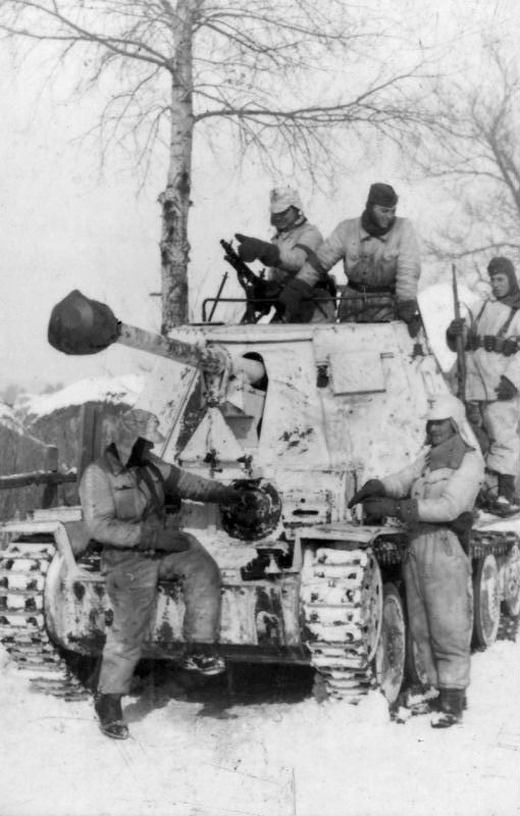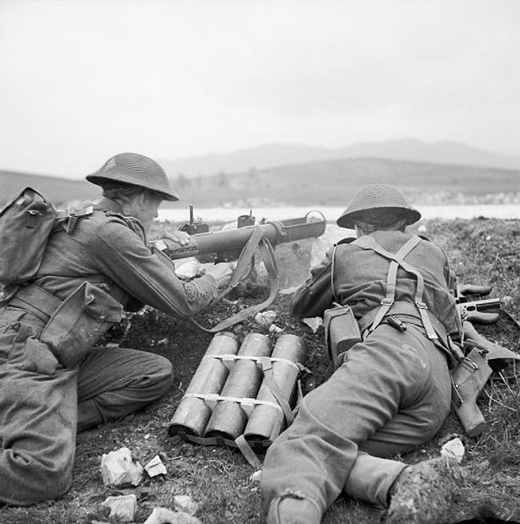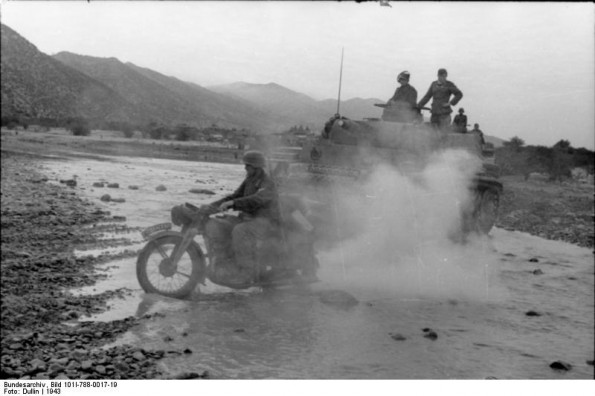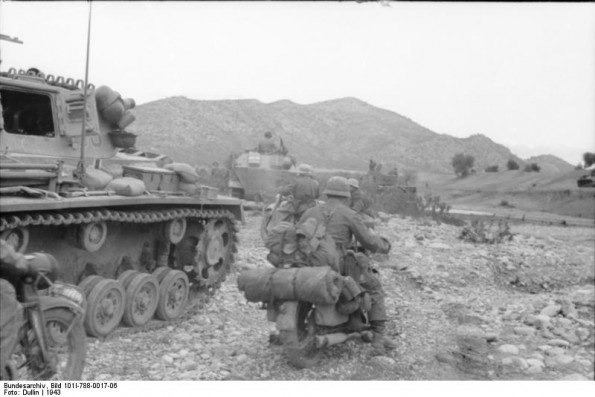Air Operations, Bismarcks
90th Heavy Bomb Group B-24s mount single-plane attacks against shipping at Gasmata and off Cape Gloucester.
[Air Operations, CBI
BURMA- 51st Fighter Group P-40 fighter-bombers attack a Japanese Army headquarters at Hpunkizup and rail lines near Meza.
- 5 341st Medium Bomb Group B-25s attack the rail terminal at Sagaing.
Air Operations, Europe
BOMBER COMMANDDaylight Ops:
- 12 Venturas attack German naval torpedo workshops at Den Helder without a loss.
- 338 aircraft are sent to Wllhelmshave. Included in the total are 120 Wellingtons, 110 Halifaxes, 56 Stirlings and 52 Lancasters.
- Inaccurate Pathfinder marking causes this raid to be a failure. The main force drops its bombs north of the port. After the raid it is found that the Pathfinders had been issues out of date maps that did not show recent town development.
- 5 Stirlings, 4 Lancasters and 3 Wellingtons are lost.
- 2 Mosquitos bomb Dortmund and Essen without a loss.
Air Operations, New Guinea
- V Bomber Command A-20s attack Japanese Army ground troops at Angari and Butibum.
- 90th Heavy Bomb Group B-24s mount single-plane attacks against shipping off Salamaua.
Air Operations, Solomons
- V Bomber Command B-17s attack the airfield on Ballale Airdrome, the Kahili airfield on Bougainville, the seaplane base at Faisi, and shipping in the Buin area.
- During the night AirSols bombers and fighters attack the Munda Point airfield on New Georgia and nearby targets.
Air Operations, Tunisia
IX Bomber Command B-25s attack Gabes through heavy clouds.
[Battle of the Atlantic
- U-268 is sunk by Wellington 'B' of No 172 Squadron. The aircraft picked up the U-boat on radar at a range of about 4 miles. Closing in on the distance the aircraft spotted the U-boat on the surface. Four depth charges are dropped around the submarine with three exploding around the submarine. The U-boat appeared to stop and then sink.
- The US submarine Blackfish (SS-221) torpedoes and sinks the German patrol craft VP-408, but is damaged by depth charges from 2 converted trawlers and is forced to terminate her patrol.
| Class | Type VIIC |
| CO | Oberleutnant zur See Ernst Heydemann |
| Location | Atlantic, Bay of Biscay |
| Cause | Air attack |
| Casualties | 45 |
| Survivors | None |
Eastern Front
Russian armies advance south and southwest of Kharkov. Oboyan is capture by the Russians and the road and railway between Kharkov and Kursk have now been entirely cleared of the enemy. German Army Group South opens a counteroffensive toward Kharkov and Belgorod.
Soldiers of the 1st SS Panzer Division |
 |
The tank spearhead of the Soviet 6th Army advances to only 30 miles from Manstein's HQ at Zaporozhye, which Hitler is visiting, but then runs out of fuel and is knocked out by a German counterattack. The Führer flies back to Germany, giving his field marshal a free hand to launch his counteroffensive.
Knowing that the Soviets are at the end of their supply lines, he has waited for the right moment to strike. Army Detachment Hollidt is on the Mius, the 1st Panzer (III, XXX and XL Panzer Corps) is south of Krasnoarmieskoye, the 4th Panzer (XLVIII Panzer and XVII Corps) is at Zaporozhye, and the SS Panzer Corps (Leibstandarte, Das Reich and Totenkopf Divs) is near Krasnograd. Manstein unleashes his attack, with the SS Corps shattering the flank of the 6th Army at Zmiyef, and XL Panzer Corps also hits the Soviet 6th Army.[MORE]
[Mediterranean
Wellington 'S' of No 38 Squadron RAF is covering a British convoy off the Libyan coast when U-562 is spotted directly below the aircraft. The aircraft attacked, but was not successful. The destroyers Isis and Hursley, convoy escorts, are called in and they destroy the U-boat in a series of depth-charge attacks.
| Class | Type VIIC |
| CO | Kaptitänleutnant Horst Hamm |
| Location | Mediterranean, NE of Benghazi |
| Cause | Depth charge |
| Casualties | 49 |
| Survivors | None |
North Africa
TUNISIAThe next phase of the Axis attack begins. It is to be more ambitious than the first, but on the orders of the Italian High Command it is to be directed toward Le Kef, as the Allies in fact expect and occupied by the British 6th Arm Div, and not Tebessa, as Rommel wishes. There are two wings to the assault. One, involving units of 15th Pzr, goes in from Kasserine toward Thala, and the other by 21st Pzr is already beyond Sbeitla aiming north for Sbiba. Rommel has managed to have von Arnim ordered to put 10th Pzr under his command, but von Arnim does not release the whole division and keeps the Tiger battalion especially. The Allies have prepared to meet attacks in both passes, and as a result resistance is fairly strong.
Projectile Infantry Anti-Tank (PIAT) |
 |
Gen Alexander, upon visiting the front, finds the situation so serious he takes command of the 18th Army Group at once, a day ahead of schedule. The 18th Army Group conprises the British 1st and 8th Armies, the French XIX Corps, and the US II Corps. The British 1st Army retains command of the French and US corps. Upon taking command, Gen Alexander orders the British, US and French forces to organize under separate commands and their respective commanders at once. The front is held by static troops while armored and mobile forces are withdrawn as a reserve striking force. Plans are made to regain the initiative.
The French XIX Corps contains a German tank-infantry attack on Sbiba Pass, where a strong defense force, consisting of the US 34th Div, the 18th Regimental Combat Team of the US 1st Div, and French units, is stationed. In the US II Corps area, the enemy opens an attack on Kasserine Pass with tanks and infantry, supported by artillery, and succeeds in gaining positions within it but cannot drive the defenders out. Some reinforcements are sent forward to bolster the Allied positions. Combat Command B, 1st Armored Div, is alerted for possible commitment.
|
|
Pacific
- The Japanese destroyer Oshio is sunk by the American submarine Albacore (SS-218) near Manus Island in the Admiralty Islands.
- The US heavy cruiser Indianapolis (CA-35) and destroyers Coghlan (DD-606) and Gillespie (DD-609) intercept the Japanese cargo ship Aragane Maru (3121t) bound for the Aleutians and engage her northwest of Attu, Aleutians.
- The US submarine Gato (SS-212) torpedoes the Japanese ammunition ship Hibari Maru (6550t) off eastern Bougainville.
- The US submarine Grampus (SS-207) torpedoes the Japanese transport/aircraft ferry Keiyo Maru (6442t).
Solomons
American reinforcements are being landed on Guadalcanal in preparation for the next move on the Russell Islands which are now reported abandoned by the Japanese.
[
